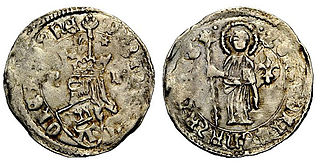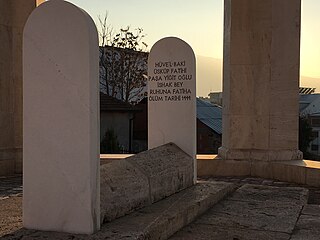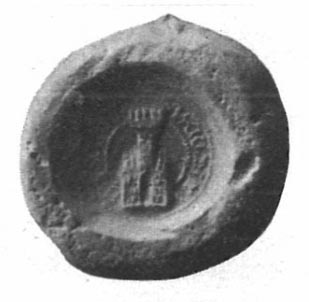Sandalj may refer to:
- Sandalj, Serbia, a village near Valjevo
- Sandalj Hranić, medieval Bosnian nobleman
Sandalj may refer to:
Vlatko Vuković Kosača was a 14th-century Bosnian nobleman who held the titles of the Duke of Hum and Grand Duke of Bosnia. He distinguished himself as one of the best military commanders of King Tvrtko I in battles against the Ottoman Empire.

Stephen Tvrtko II, also known as Tvrtko Tvrtković, was a member of the House of Kotromanić who reigned as King of Bosnia from 1404 to 1409 and again from 1420 to his death.

The House of Kosača, somewhere Kosačić, was a Bosnian medieval noble family which ruled over parts of modern-day Bosnia and Herzegovina, Croatia, Montenegro, and Serbia between the 14th century and the 15th century. The land they controlled was known as Humska zemlja, roughly corresponding to modern region of Herzegovina, which itself was derived from the title "Herzog", which Stjepan Vukčić Kosača adopted in 1448., with latin title "Dux Sancti Sabbae". Besides Hum, they ruled parts of Dalmatia and Rascia. They were vassals to several states, including the Kingdom of Bosnia and Ottoman Empire. Historians think the Kosača family is part of the Kőszegi family, but there is a lack of evidence for this claim.
The religious confession of the Kosača family is uncertain. They were in contact with the Eastern Orthodox Church, the Church of Bosnia, the Roman Catholic Church and Islam. During the fall of the Bosnian Kingdom, the "Kosače" split into three branches: Venetian, Dalmatian and Ottoman. From then onward, these branches became accepting of the Roman Catholic faith, in the first two cases, and of Islam in the third.
Sandalj Hranić Kosača was a powerful Bosnian nobleman whose primary possessions consisted of land areas between Adriatic coast, the Neretva and the Drina rivers in Bosnia, and served the court as the Grand Duke of Bosnia sometime between 1392 and his death in 1435, although the first mention as a Grand Duke in sources comes from 16 June 1404. He was married three times, but had no children. After his death, he was succeeded by his nephew Stjepan Vukčić Kosača.

Stjepan Vukčić Kosača was a powerful Bosnian nobleman who was politically active from 1435 to 1465; the last three decades of Bosnian medieval history. During this period, three kings acceded to the Bosnian throne: Tvrtko II, Thomas (Tomaš), Stephen Tomašević (Stjepan Tomašević) and anti-king Radivoj—the older brother of King Thomas—before the country was conquered by the Ottomans.

The Kingdom of Bosnia, or Bosnian Kingdom, was a medieval kingdom that lasted for nearly a century, from 1377 to 1463, and evolved out of the Banate of Bosnia, which itself lasted since at least 1154.

Ishak Bey or Ishak-Beg or Ishak-Beg Hranić was an Ottoman governor and soldier, the sanjakbey of Üsküb from 1415 to 1439.

Sandalj is a village in the municipality of Valjevo, Serbia. According to the 2002 census, the village has a population of 155 people.
Jelena Lazarević, also known, by marriages, as Jelena Balšić or Jelena Hranić or Jelena Kosača, was a medieval Serbian princess, daughter of Prince Lazar of Serbia and Princess Milica Nemanjic. She had a very strong personality and significantly influenced the way her husbands, first Đurađ II Balšić and second Sandalj Hranić Kosača, and her son Balša III governed their realms. Jelena encouraged them to resist Venetian encroachment on territory belonging to Zeta, the medieval Serbian state ruled by Đurađ II and then by Balša III after Đurađ II's death. She is also known as a writer in epistolary literature, particularly her correspondence with Nikon of Jerusalem, a monk in the Gorica monastery on Lake Skadar (Montenegro). Her three epistles are part of the Gorički zbornik, a medieval manuscript collection.

Pavle Radinović, sometimes Radenović,, was one of the most powerful Bosnian nobleman under Tvrtko I, Dabiša, Jelena Gruba, Ostoja, Tvrtko II and Ostoja again. He was a knez and the head of Radinović-Pavlović noble family, a powerful magnate clan whose initially possessions spread from central to eastern Bosnia, gravitating around the Prača - Miljacka river axis, between the Krivaja Drina and the Upper Bosna rivers, with the seat in Borač and Pavlovac between Prača and Rogatica, and also held mines in Olovo and Fojnica.

Ostrovica Fortress is a ruined medieval fortification on a solid rock jutting from the top of the hill above the village of Ostrovica in Zadar County, Croatia. It is located between the two historical and geographical regions, Bukovica and Ravni Kotari. It was once an important stronghold, known as the "Key to the City of Zadar", as it was a key defense of the city. It was destroyed during the Ottoman–Venetian Wars in the second half of the 17th century, leaving only a few remains.
Vukosav Nikolić was mid-ranking Bosnian nobleman and a vassal to Kosača-Vukčić family under Sandalj Hranić, who served the Kingdom of Bosnia during the reign of his relative Jelena Gruba and Stephen Ostoja ,. He was the lord of Neum, the Popovo field, and the Lower Neretva region. He fell in battle during the Bosnian-Ragusan War (1403).
Bosnian–Ragusan War (1403–1404), sometimes called Second Bosnian–Ragusan War, was a military conflict fought between the Kingdom of Bosnia and the Republic of Ragusa between 1403 and 1404, which ended with a treaty signed officially in 1405. In 1403 Stephen Ostoja of Bosnia sided with King Ladislaus of Naples in his plights against the Hungarian King Sigismund, Bosnia's liege. King Ostoja led a war against the Ragusans, Sigismund's allies.
Vukac Hranić Kosača was powerful Bosnian magnate and nobleman from Kosača noble family with the title of knez, during the reigns of Tvrtko II, Stephen Ostoja, Stephen Ostojić and Tvrtko II again.

The Ostrovica Castle is a large medieval structure situated above the small village of Ostrovica near Kulen Vakuf, Bihać municipality, Bosnia and Herzegovina. Having been built on a heavily wooded ridge of a steep hill overlooking left bank of the shallow Una river, the castle was located on a strategic site connecting the northern and southern parts of the long Una valley.
Grand Duke of Bosnia was a court title in the Bosnian medieval state, with its first holders being recorded around the middle of the 14th century. The title was bestowed by the monarch to its highest military commander, rarely two, usually reserved for the most influential and most capable among the highest most prominent Bosnian nobility highest Bosnian nobility. It was very much different from the Grand duke title found in Europe at the time. To interpret it as an office post rather than a court rank could be equally accurate, and although it was retained for life by a nobleman who gained it, it was not meant to be hereditary, at least not at first. although it was not hereditary at first, it served both purposes and was retained for life by a nobleman who gained it. However, in the last several decades of the Bosnian medieval state it became hereditary, which means it became more than just an office or a court rank.
Hrana Vuković was a Bosnian magnate who ruled the area between Neretva and Drina rivers in Bosnia with the title Grand Duke of Bosnia prior to 1380. He was the father of Sandalj Hranić and brother of Vlatko Vuković. After his death, he was succeeded by Vlatko Vuković as a head of Vuković-Kosača family, and Hrvoje Vukčić as a Grand Duke of Bosnia.

Ključ fortrass, locally known as Stari grad Ključ, is a medieval castle complex in the village of Ključ, Gacko, Bosnia and Herzegovina. The historic area includes the Ključ fortress, the Podključ castle town as part of a wider area just beneath of the fortress, the Ključ Mosque with a harem. The site has been declared a National monument of Bosnia and Herzegovina by the Commission to preserve national monuments of Bosnia and Herzegovina.
Radoslav Pavlović, sometimes spelled Radislav, Radisav or Radosav, was a Bosnian nobleman of the noble family Pavlović-Radinović. He inherited title of knez from his father Pavle Radinović upon his father death, while his older brother Petar (1415–1420), being the first in order of precedence, was bestowed a title of duke by the Bosnian throne. He and his brother also inherited their father's estates in the eastern parts of the Kingdom of Bosnia. After the murder of his father Pavle Radinović on Parena Poljana, near Sutjeska and Bobovac, in 1415 by the hand of Grand Duke of Bosnia, Sandalj Hranić (1392–1435), Radosav together with his older brother Peter, started a war against Sandalj Hranić and his Kosača clan, as those responsible for the murder. After the death of his older brother Petar in the conflict with the Ottomans in 1420, Radosav assumed leadership over the Pavlović's clan and took over the title of duke, and around 1421 he was bestowed a title of Grand Duke of Bosnia by the throne. He ended the conflicts with the Kosača and sealed the peace with a marriage with the daughter of Vukac Hranić, princess Teodora, the sister of the future Kosača's clan chieftain, Stjepan Vukčić (1435—1466), with whom he had three sons. In 1426, he sold his part of Konavle to the Republic of Ragusa for 18,000 perpers, but in 1430 he started the so-called First Konavle War over the sold territories, which ended in 1432 with the recognition of the situation from the beginning of the conflict. In 1435, after the death of Duke Sandalj Hranić, he tried to take advantage of the new situation, but in a conflict with his wife's brother Stjepan, he eventually lost the southern parts of his zemlja around Trebinje. He died in 1441, and was succeeded by his son Ivaniš Radoslavić Pavlović (1441—1450).
Katarina Vuković, from the medieval Bosnian noble lineage of Hrvatinić, was the second wife of Grand Duke of Bosnia, Sandalj Hranić.